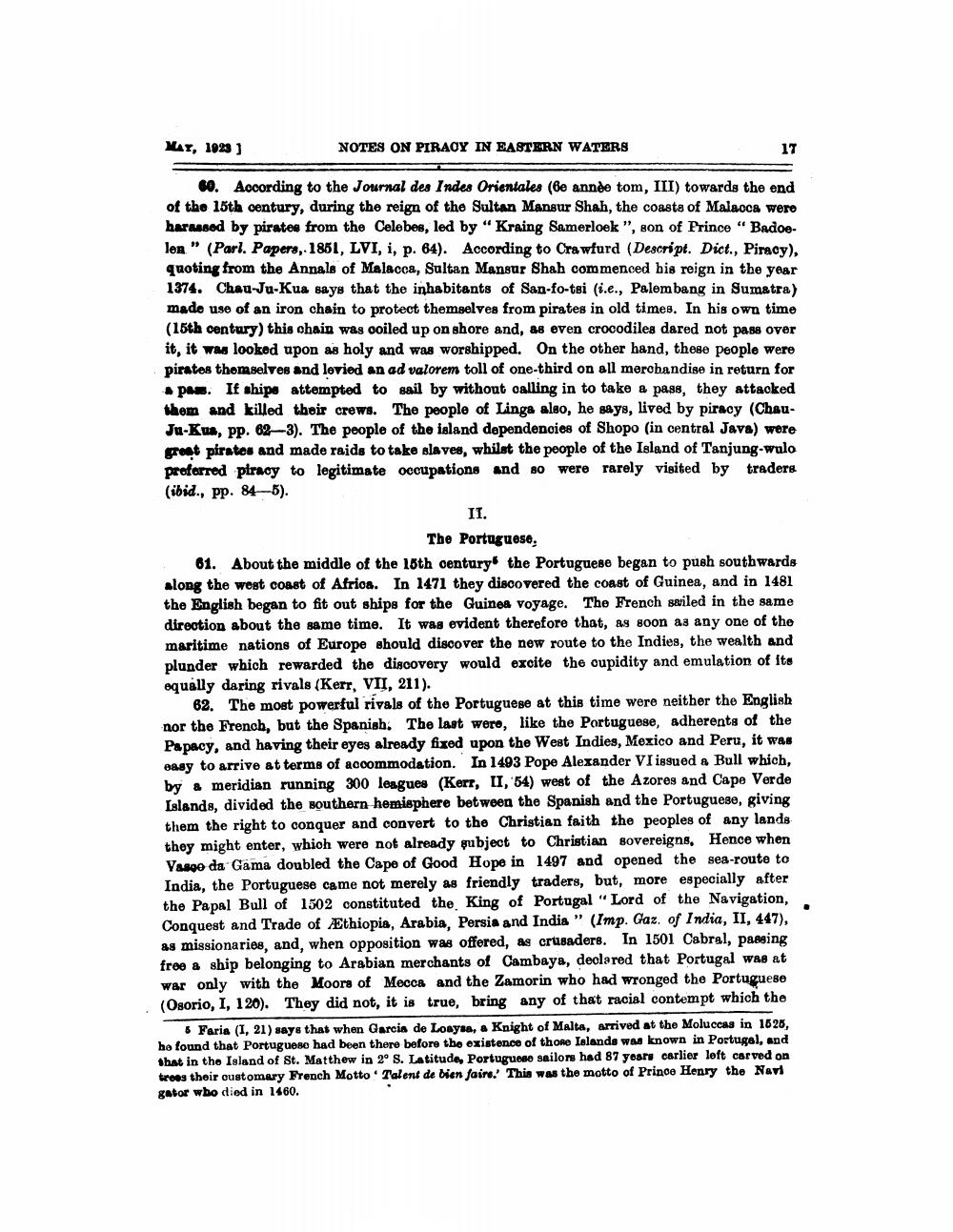________________
MAY, 1923]
NOTES ON PIRACY IN EASTERN WATERS
17
60. According to the Journal des Indes Orientales (6e année tom, III) towards the end of the 15th century, during the reign of the Sultan Mansur Shah, the coasts of Malacca were harassed by pirates from the Celebes, led by "Kraing Samerloek ", son of Prince "Badoelen" (Parl. Papers, 1851, LVI, i, p. 64). According to Crawfurd (Descript. Dict., Piracy), quoting from the Annals of Malacca, Sultan Mansur Shah commenced his reign in the year 1374. Chau-Ju-Kua says that the inhabitants of San-fo-tsi (i.e., Palembang in Sumatra) made use of an iron chain to protect themselves from pirates in old times. In his own time (15th century) this chain was ooiled up on shore and, as even crocodiles dared not pass over it, it was looked upon as holy and was worshipped. On the other hand, these people were pirates themselves and levied an ad valorem toll of one-third on all merchandise in return for a pass. If ships attempted to sail by without calling in to take a pass, they attacked them and killed their crews. The people of Linga also, he says, lived by piracy (ChauJu-Kua, pp. 62-3). The people of the island dependencies of Shopo (in central Java) were great pirates and made raids to take slaves, whilst the people of the Island of Tanjung-wulo preferred piracy to legitimate occupations and so were rarely visited by traders (ibid., pp. 84-5).
II.
The Portuguese,
61. About the middle of the 15th century the Portuguese began to push southwards along the west coast of Africa. In 1471 they discovered the coast of Guinea, and in 1481 the English began to fit out ships for the Guinea voyage. The French sailed in the same direction about the same time. It was evident therefore that, as soon as any one of the maritime nations of Europe should discover the new route to the Indies, the wealth and plunder which rewarded the discovery would excite the cupidity and emulation of its equally daring rivals (Kerr, VII, 211).
62. The most powerful rivals of the Portuguese at this time were neither the English nor the French, but the Spanish. The last were, like the Portuguese, adherents of the Papacy, and having their eyes already fixed upon the West Indies, Mexico and Peru, it was easy to arrive at terms of accommodation. In 1493 Pope Alexander VI issued a Bull which, by a meridian running 300 leagues (Kerr, II, 54) west of the Azores and Cape Verde Islands, divided the southern hemisphere between the Spanish and the Portuguese, giving them the right to conquer and convert to the Christian faith the peoples of any lands they might enter, which were not already subject to Christian sovereigns, Hence when Vasco da Gama doubled the Cape of Good Hope in 1497 and opened the sea-route to India, the Portuguese came not merely as friendly traders, but, more especially after the Papal Bull of 1502 constituted the King of Portugal "Lord of the Navigation, Conquest and Trade of Ethiopia, Arabia, Persia and India" (Imp. Gaz. of India, II, 447), as missionaries, and, when opposition was offered, as crusaders. In 1501 Cabral, passing free a ship belonging to Arabian merchants of Cambaya, declared that Portugal was at war only with the Moors of Mecca and the Zamorin who had wronged the Portuguese (Osorio, I, 120). They did not, it is true, bring any of that racial contempt which the
5 Faria (1, 21) says that when Garcia de Loaysa, a Knight of Malta, arrived at the Moluccas in 1525, he found that Portuguese had been there before the existence of those Islands was known in Portugal, and that in the Island of St. Matthew in 2° S. Latitude, Portuguese sailors had 87 years earlier left carved on trees their customary French Motto Talent de bien faire. This was the motto of Prince Henry the Navi gator who died in 1460.




